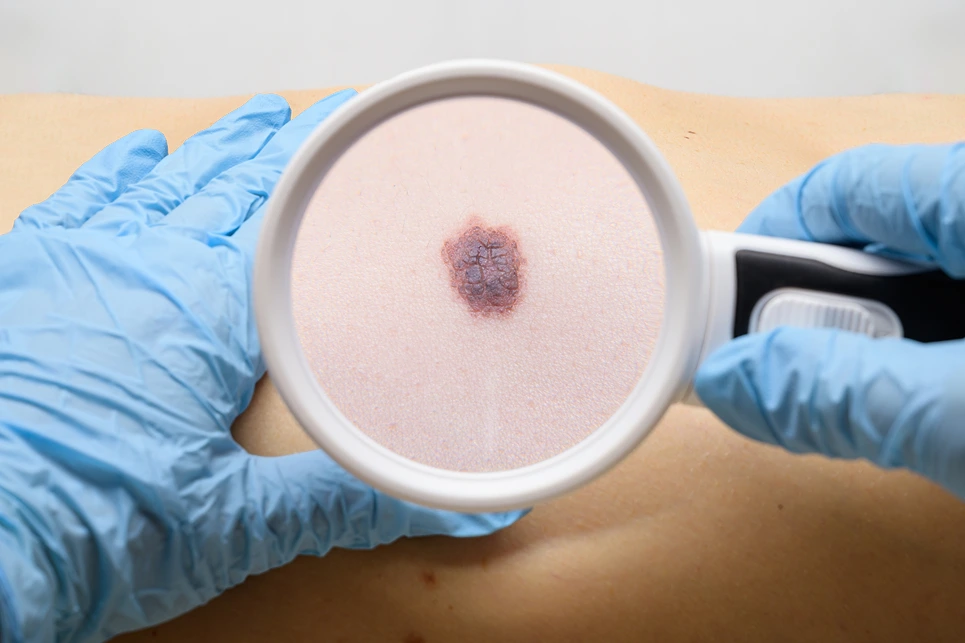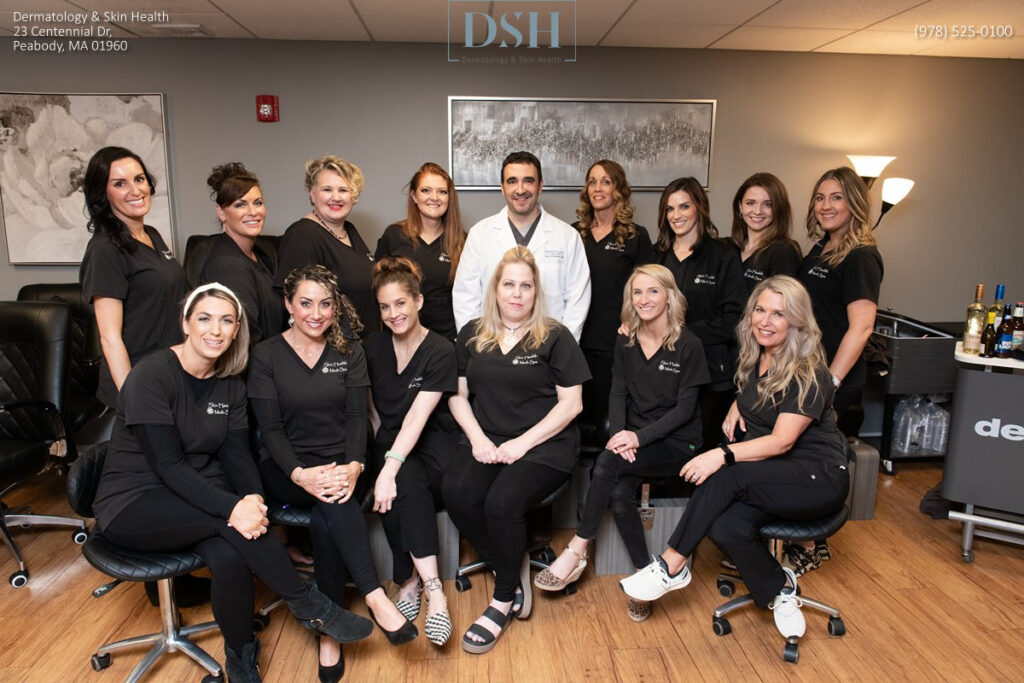

That small, pearly bump on your nose seems harmless enough. But over time, you notice it growing larger, taking on a waxy, scar-like appearance. Annoying, yes, but certainly nothing to worry about—or is it?
That innocent-looking spot could actually be a sign of basal cell carcinoma (BCC), the most common form of skin cancer. And while it may not sound threatening, BCC can be disfiguring or even deadly if not treated promptly and properly.
So how do you know when to take action against BCC? And what is the optimal treatment option to eliminate these cancerous spots for good?
Many doctors turn to a specialized technique called Mohs surgery—the single most effective treatment for basal cell carcinoma available today. When performed soon after diagnosis, Mohs offers the best chance of removing BCC completely and minimizing its chances of returning.
It may come as a surprise, but skin cancer is the most common cancer in the United States. And basal cell carcinoma accounts for approximately 80% of all skin cancer cases, with nearly 4 million new diagnoses every year.
BCC arises from abnormal growths in the basal cells, or the lowest layer of the epidermis. These cells proliferate rapidly, forming cancerous clusters that can damage surrounding healthy tissue.
While basal cell carcinoma is locally invasive, it rarely spreads to other parts of the body.
But without prompt treatment, BCC can be disfiguring or even penetrative to deeper structures like cartilage and bone.
| Stage | Description |
| Stage 0 | Precancerous lesion or carcinoma in situ with no invasion |
| Stage 1 | Small localized tumor less than 2cm in size |
| Stage 2 | Larger tumor greater than 2cm with limited local invasion |
| Stage 3 | Extensive local invasion into facial bones, nerves, blood vessels |
Like most cancers, detecting BCC in its early stages offers the best prognosis. Some warning signs to look out for include:
These growths most commonly appear on frequently sun-exposed areas like the face, neck, ears, scalp, shoulders, and back. But BCC can develop anywhere on the body. Regular self-exams and professional skin checks are key to identifying any new or changing spots promptly.
If you notice any suspicious lesions, don’t delay—schedule a skin biopsy right away. Catching BCC early while it is still small and localized is the best way to stop it in its tracks before significant damage can occur.
Once biopsy results confirm a basal cell carcinoma diagnosis, your dermatologist will determine the best treatment plan based on the tumor’s unique characteristics. Treatment options include:
For high-risk BCC cases, Mohs micrographic surgery offers the single highest likelihood of eliminating the cancer completely. This technique involves surgically removing the visible tumor layer by layer, examining the margins after each pass to map out any remaining cancerous roots. This allows complete removal of cancerous tissue while preserving as much healthy skin as possible.
For recurrent BCC, large tumors, or cancers in delicate areas like the face, Mohs surgery provides the optimal chance to eliminate the cancer while minimizing collateral damage. It’s critical to schedule Mohs surgery promptly after diagnosis for the highest likelihood of success.
Unlike other BCC treatments that remove only the visible portion of the tumor, Mohs surgery allows the surgical team to view 100% of the surgical margins microscopically.
This enables the precise identification and mapping of any cancerous roots or extensions beyond the initial lesion. Removing BCC in stages until no residual cancer cells remain provides the highest cure rate of any treatment available—up to 99% for basal cell carcinomas.
To achieve these optimal results, most Mohs procedures are scheduled as soon as possible after confirming BCC diagnosis via biopsy. Delays between diagnosis and surgery can allow the cancer time to spread into surrounding healthy tissue, making removal more invasive and increasing recurrence risk. While timing varies case by case, most patients undergo Mohs surgery within 1-2 weeks of diagnosis.
For more aggressive BCC cases, or in sensitive locations like around the eyes, surgery may be scheduled immediately—even the next day—after diagnosis. Rapid coordination between your dermatologist, Mohs surgeon, and support team allows expedited treatment to halt BCC progression quickly before extensive damage can accrue.

Several key considerations guide the optimal timing for Mohs surgery after basal cell carcinoma diagnosis:
Larger, faster-growing, or recurrent BCC tumors may require more urgent surgery to avoid penetration into nerves, blood vessels, or other critical structures. Cancers near the eyes, nose, ears and other delicate features also often warrant immediate Mohs surgery to protect vital functions and appearance.
The tumor’s histology, or microscopic structure, provides clues about its aggressiveness. More concerning histologic subtypes like morpheaform BCC represent rapid, invasive growth requiring quick action. Clear pathology reports inform surgical urgency and planning.
As a specialized procedure, Mohs requires an extensively trained surgical team. Scheduling availability of your Mohs surgeon factors into timely coordination of treatment after diagnosis. Reputable Mohs surgeons often book out weeks in advance to accommodate urgent cases like yours.
Before any surgery, it’s important to optimize health factors through medication management, nutrition and fitness. Controlling diabetes, avoiding blood thinners, and curbing smoking all support safe, effective treatment. Your doctor will help stabilize any outstanding medical issues beforehand.
In consultation with your dermatologist and Mohs surgeon, you can discuss case specifics and priorities to tailor the treatment timeline. Advanced BCC may require rapid, aggressive treatment.
While most patients desire treatment as soon as safely possible, the ultimate schedule reflects a balance of clinical aggressiveness and personal needs. Clear conversations empower patients like you to make informed decisions about managing BCC without unnecessary delay.
Preparing for Mohs surgery helps patients know what to expect during treatment and recovery. Your Mohs surgeon will provide thorough pre-operative guidelines to follow. Typical steps include:
The surgery begins with administering a local anesthetic to keep you comfortable. Your Mohs surgeon then removes the visible tumor using a scalpel, plus an additional margin of healthy tissue for analysis. You remain awake throughout the procedure.
Next, the surgical team maps and colors the edges of the removed tissue sample to orient it precisely. They examine the margins under a microscope, looking for any remaining cancer cells.
If cancer cells are still present, your surgeon removes another thin layer of tissue, with the map guiding them exactly where to target. This process repeats until the margins are fully clear. For larger tumors, surgeons may remove 5 layers or more until no BCC remains.
Once cancer-free margins are achieved, your surgeon closes and dresses the wound. Stitches, skin grafts, or flaps may be used depending on the wound size and location. You receive post-op wound care instructions before heading home.
Patients normally return home the same day once recovered from the local anesthesia. Some temporary swelling, bruising and discomfort are common. But most patients become mobile again within just a day or two. Your team closely monitors your progress and schedules follow-up visits to change bandages and eventually remove stitches as the site heals.

If you notice any unusual skin lesions or have been diagnosed with basal cell carcinoma, don’t hesitate to schedule an initial biopsy and consultation. Catching BCC early maximizes your treatment options and prognosis.
Schedule a consultation with Dermatology and Skin Health today to discuss your concerns and design an effective treatment plan tailored to your unique needs.
Whether you are dealing with a common skin condition like acne or eczema or a more serious issue like skin cancer, we have the experience and advanced solutions to get your skin back to its best.
If your desired appointment type or preferred provider is unavailable online, kindly call (978) 525-0100 for Peabody, MA and (603) 742-5556 for all New Hampshire locations. Alternatively please feel free to send us your request via the patient portal, or via email at info@dermskinhealth.com
*For medical dermatology appointments in MA please dial (978) 525-0100 or fill out the appointment request form above.